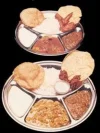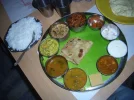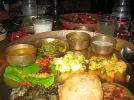- Joined
- Mar 16, 2002
- Messages
- 6,660
- Reaction score
- 578
You guys are nuts! 
No one really knows anything about curry and all you guys talk as if you were all born and bred in the Sub Continent
Korma (mentioned by Chris)
A traditional korma will have a long slow cooking. In fact, korma is not one particular dish but rather a method of cooking similar to braising. Because korma is a cooking method there are a wide variety of dishes that could be described as "korma". Many kormas call for the meat to be marinated in yoghurt and then the meat plus marinade are braised on a very low heat until all the juices condense down into a thick sauce. The restaurant chef has to cook to order so doesn't have time for long, slow cooking. The korma you find in Indian restaurants usually contains ground almonds, coconut and thick cream. It is often described on restaurant menus as being "very mild" but a good korma should not be bland.
Vindaloo (mentioned my Sir Flops)
The vindaloo was originally a Portuguese dish which took its name from the 2 main ingredients which were "vinho", wine/wine vinegar, and "alhos", garlic. Over time it was spiced up, hotted up and otherwise changed by the indigenous peoples of the ex-Portuguese colony of Goa. Not many restaurants produce an authentic Goan vindaloo not least because the pork used by Christian Goans in their recipe would not be acceptable to Muslim chefs. In some restaurants the vindaloo is just a pumped-up Madras i.e. the same recipe but with lots more chilli powder. Other restaurants have interpreted the "aloo" part of the name as meaning potato and introduced diced potato to a hot standard curry with added lemon juice for tartness and black pepper for extra pungency. Very hot.
Jalfrezi (mentioned by bodhi)
Jalfrezi is not a traditional Indian dish as such but, like the bhuna, is actually a method of cooking. It literally means "hot-fry" but is probably better translated as "stir-fry". The term jalfrezi entered the English language at the time of the British Raj in India. Colonial households employed Indian cooks who would use the jalfrezi method of cooking to heat up cold roasted meat and potatoes. But the restaurant jalfrezi is not a version of the Anglo-Indian dish. Oh no. The Indian restaurant chef uses the jalfrezi method to stir-fry green peppers, onions and plenty of green chillies as the basis for a curry with just a little sauce. The chillies make the jalfrezi taste very fresh but also make it one of the hotter curries on the restaurant menu.
Another type of dish which is very nicely done depending on the restaurant.
Saag
Saag gosht is a classic curry traditionally made with spinach and lamb. Saag is, strictly speaking, a general term for tender green leaves such as spinach, mustard greens and fresh fenugreek leaves. If you were talking about spinach on its own it would be called palak. Many restaurants these days will offer a chicken or a prawn alternative to lamb and so the dish will show on the menu as just "saag" or "palak" omitting the gosht (lamb) from the name altogether. The saag is usually served medium hot and is made in the bhuna style.
I personally very much like the Thali, it offers very good variety and is a complete mean in all respects. The best part is if you do not like a particular dish you can very well leave it alone. It actually has anywhere from six to 10 items and is like a full course meal including dessert.
The Thali invariably always has a couple of styles of Dhal in the offering and vegetables. Let me explain what Dhal really means. Dhal refers to any of the pulse family - dried peas, beans and lentils. There are hundreds of types of dhal but the most common in restaurants are "masoor dhal" (split red lentils) and "chana dhal". The word dhal is also used to describe the name of the finished dish. e.g. tarka dhal where cooked dhal is garnished with fried garlic and spiced oil.
Methi (Fenugreek), Ghost (lamb meat). Methi Ghost is another great dish which I have personally known many from UK like. Restaurants typically use the leaves rather than the seeds. The dried leaves have a pungent aroma. In a dish such as methi aloo (potato) the fenugreek leaves should be fresh rather than dried. In their fresh form the leaves are milder and used like spinach.
If anyone is interested in a Chicken Tikka Recipe to try at home here is a very good one which I whole heartedly recommend. Its very easy and above all healt
Chicken Tikka (mentioned by psd99)
Ingredients
I think I may start a thread about dishes from sub-continent just like my humour thread Unless you all think it is a lousy idea
Unless you all think it is a lousy idea

No one really knows anything about curry and all you guys talk as if you were all born and bred in the Sub Continent

Korma (mentioned by Chris)
A traditional korma will have a long slow cooking. In fact, korma is not one particular dish but rather a method of cooking similar to braising. Because korma is a cooking method there are a wide variety of dishes that could be described as "korma". Many kormas call for the meat to be marinated in yoghurt and then the meat plus marinade are braised on a very low heat until all the juices condense down into a thick sauce. The restaurant chef has to cook to order so doesn't have time for long, slow cooking. The korma you find in Indian restaurants usually contains ground almonds, coconut and thick cream. It is often described on restaurant menus as being "very mild" but a good korma should not be bland.
Vindaloo (mentioned my Sir Flops)
The vindaloo was originally a Portuguese dish which took its name from the 2 main ingredients which were "vinho", wine/wine vinegar, and "alhos", garlic. Over time it was spiced up, hotted up and otherwise changed by the indigenous peoples of the ex-Portuguese colony of Goa. Not many restaurants produce an authentic Goan vindaloo not least because the pork used by Christian Goans in their recipe would not be acceptable to Muslim chefs. In some restaurants the vindaloo is just a pumped-up Madras i.e. the same recipe but with lots more chilli powder. Other restaurants have interpreted the "aloo" part of the name as meaning potato and introduced diced potato to a hot standard curry with added lemon juice for tartness and black pepper for extra pungency. Very hot.
Jalfrezi (mentioned by bodhi)
Jalfrezi is not a traditional Indian dish as such but, like the bhuna, is actually a method of cooking. It literally means "hot-fry" but is probably better translated as "stir-fry". The term jalfrezi entered the English language at the time of the British Raj in India. Colonial households employed Indian cooks who would use the jalfrezi method of cooking to heat up cold roasted meat and potatoes. But the restaurant jalfrezi is not a version of the Anglo-Indian dish. Oh no. The Indian restaurant chef uses the jalfrezi method to stir-fry green peppers, onions and plenty of green chillies as the basis for a curry with just a little sauce. The chillies make the jalfrezi taste very fresh but also make it one of the hotter curries on the restaurant menu.
Another type of dish which is very nicely done depending on the restaurant.
Saag
Saag gosht is a classic curry traditionally made with spinach and lamb. Saag is, strictly speaking, a general term for tender green leaves such as spinach, mustard greens and fresh fenugreek leaves. If you were talking about spinach on its own it would be called palak. Many restaurants these days will offer a chicken or a prawn alternative to lamb and so the dish will show on the menu as just "saag" or "palak" omitting the gosht (lamb) from the name altogether. The saag is usually served medium hot and is made in the bhuna style.
I personally very much like the Thali, it offers very good variety and is a complete mean in all respects. The best part is if you do not like a particular dish you can very well leave it alone. It actually has anywhere from six to 10 items and is like a full course meal including dessert.
The Thali invariably always has a couple of styles of Dhal in the offering and vegetables. Let me explain what Dhal really means. Dhal refers to any of the pulse family - dried peas, beans and lentils. There are hundreds of types of dhal but the most common in restaurants are "masoor dhal" (split red lentils) and "chana dhal". The word dhal is also used to describe the name of the finished dish. e.g. tarka dhal where cooked dhal is garnished with fried garlic and spiced oil.
Methi (Fenugreek), Ghost (lamb meat). Methi Ghost is another great dish which I have personally known many from UK like. Restaurants typically use the leaves rather than the seeds. The dried leaves have a pungent aroma. In a dish such as methi aloo (potato) the fenugreek leaves should be fresh rather than dried. In their fresh form the leaves are milder and used like spinach.
If anyone is interested in a Chicken Tikka Recipe to try at home here is a very good one which I whole heartedly recommend. Its very easy and above all healt
Chicken Tikka (mentioned by psd99)
Ingredients
- 2 pounds chicken legs, thighs or breasts
- 1 teaspoon salt
- 1 teaspoon red chili powder
- 1 teaspoon coriander seeds, roasted, ground
- 2 teaspoons garlic - minced
- 2 teaspoons ginger, fresh - grated
- 4 tablespoons plain yogurt (full fat)
- 2 tablespoons lemon juice or white wine vinegar
- 1/2 teaspoon black pepper - ground
- vegetable oil
- NOTE : You can add some red food coloring to the marinade paste for the traditional red color of this chicken dish.
- Remove the skin and make 2-3 deep cuts in each chicken piece.
- Roast the corriander seeds in a hot cast iron skillet. After cooling, grind to powder.
- Mix all dry ingredients with the lemon juice or vinegar and make a paste.
- Put this paste onto chicken pieces and leave them for at least 4-5 hours to marinate. Better if left in refrigerator over night.
Grill method - Rub each piece of chicken with a few drops of vegetable oil.
- Grill the chicken using indirect heat over hot coals.
Oven method - Put the chicken pieces (with the paste still on it) onto a broiler tray and cover them with aluminum foil.
- Put the tray into a medium oven (350 F) for 30 minutes.
- Then remove tray and pour off any liquid. Baste chicken with 2 tablespoons of oil and return to the oven for another 15 minutes until outside of chicken is crispy.
I think I may start a thread about dishes from sub-continent just like my humour thread
 Unless you all think it is a lousy idea
Unless you all think it is a lousy idea








